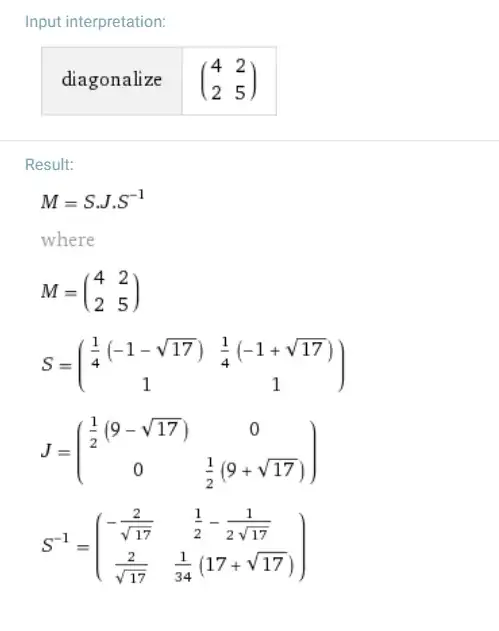Your quadratic form is given as:
$$\boldsymbol{x}^T\boldsymbol{Px}$$
Now use the substitution (for a justification see below)
$$\boldsymbol{x} = \boldsymbol{V}\boldsymbol{\Lambda}^{-1/2} \boldsymbol{w} ,$$
in which $\boldsymbol{\Lambda}$ is a diagonal matrix containing the eigenvalues of $\boldsymbol{P}$ and $\boldsymbol{V}$ is the matrix containing the normalized eigenvectors associated with $\boldsymbol{\Lambda}$. Note, that in your case you can choose the eigenvectors in such a fashion that $\boldsymbol{V}$ is orthonormal. Then do the substitution of the integral by using the determinant of the Jacobian for this substitution.
Edit: In order to solve the problem, you will need to determine the Jacobian of the substitution
$$\boldsymbol{x} = \boldsymbol{V}\boldsymbol{\Lambda}^{-1/2} \boldsymbol{w}$$
as this is a linear expression the Jacobi determinant is given by
$$\det \left[\boldsymbol{V}\boldsymbol{\Lambda}^{-1/2}\right].$$
The integral is then given by
$$\int_{\Bbb R^2}e^{-\boldsymbol{w}^T\boldsymbol{w}}\det \left[\boldsymbol{V}\boldsymbol{\Lambda}^{-1/2}\right]d\boldsymbol{w}=\det \left[\boldsymbol{V}\boldsymbol{\Lambda}^{-1/2}\right]\int_{\Bbb R^2}e^{-\boldsymbol{w}^T\boldsymbol{w}}d\boldsymbol{w}.$$
The last expression is a well-known result obtained by Laplace by applying a more general formula of Euler (it is often not correctly referred as the Gauss integral). It can be solved by the trigonometric substitution
$$\boldsymbol{w} = \begin{bmatrix}r\cos \varphi\\ r \sin \varphi\end{bmatrix} \implies d\boldsymbol{w} = rdrd\varphi.$$
In order to motivate my answer, we will do this step by step.
From the eigenvalue equation in matrix form and the orthonormality of $\boldsymbol{V}$
$$\boldsymbol{PV} = \boldsymbol{V\Lambda}$$
we can obtain
$$\boldsymbol{\Lambda} = \boldsymbol{V}^{-1}\boldsymbol{PV}=\boldsymbol{V}^T\boldsymbol{PV}.$$
If we transform our quadratic form by the substitution
$$\boldsymbol{x} = \boldsymbol{Vz}$$
we obtain
$$\boldsymbol{z}^T\boldsymbol{V}^T\boldsymbol{PVz}=\boldsymbol{z}^T\boldsymbol{\Lambda z}.$$
Now to transform the diagonal matrix $\boldsymbol{\Lambda}$ into the identity matrix we use
$$\boldsymbol{z}=\boldsymbol{\Lambda}^{-1/2}\boldsymbol{w}$$
if we apply this to the transformed quadratic form we can obtain
$$\boldsymbol{z}^T\boldsymbol{V}^T\boldsymbol{PVz}=\boldsymbol{w}^T\boldsymbol{\Lambda}^{-T/2}\boldsymbol{\Lambda}\boldsymbol{\Lambda}^{-1/2}\boldsymbol{w}.$$
As $\boldsymbol{\Lambda}$ is a diagonal matrix
$$\boldsymbol{\Lambda}^{-T/2}=\boldsymbol{\Lambda}^{-1/2}.$$
$$\boldsymbol{w}^T\boldsymbol{\Lambda}^{-T/2}\boldsymbol{\Lambda}\boldsymbol{\Lambda}^{-1/2}\boldsymbol{w}=\boldsymbol{w}^T\boldsymbol{\Lambda}^{-1/2}\boldsymbol{\Lambda}\boldsymbol{\Lambda}^{-1/2}\boldsymbol{w}=\boldsymbol{w}^T\boldsymbol{\Lambda}^{-1/2}\boldsymbol{\Lambda}^{1/2}\boldsymbol{\Lambda}^{1/2}\boldsymbol{\Lambda}^{-1/2}\boldsymbol{w}=\boldsymbol{w}^T\boldsymbol{w}.$$
So we really obtain a simple quadratic form. Chaining both substitutions gives
$$\boldsymbol{x} = \boldsymbol{V\Lambda}^{-1/2}\boldsymbol{w}$$
as was proposed previously.
